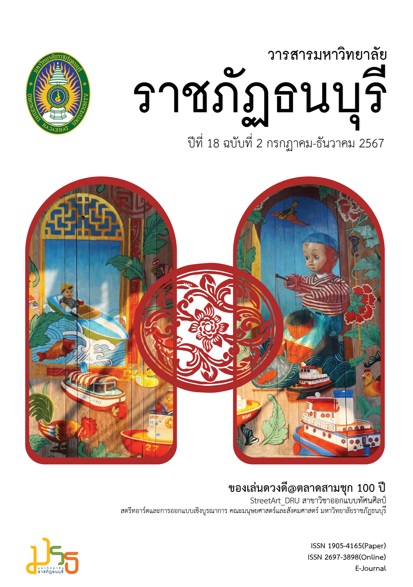Buddhist Resilience of the People in Lat Phrao District of Bangkok After the Pandemic of COVID-19
Keywords:
Buddhist resilience, After the pandemic of COVID-19, People in Lat Phrao district, BangkokAbstract
The objectives of the research were: 1) to study the level of Buddhist resilience after the COVID-19 outbreak of the people in Lat Phrao district, Bangkok, and 2) to compare the Buddhist resilience after the COVID-19 outbreak of the people in Lat Phrao district, Bangkok. The sample group consisted of 400 people using a simple random sampling method. The data were collected using a questionnaire with a confidence value of .865. The data were analyzed using descriptive statistics, including frequencies, percentages, means, standard deviations, and inferential statistics. The results of the study found that: 1) Buddhist resilience after the COVID-19 outbreak of the people in Lat Phrao district, Bangkok as a whole was at a moderate level, and Buddhist resilience after the spread of COVID-19 of the people in Lat Phrao district, Bangkok of the sample group that responded to the questionnaire, overall, was at a moderate level (Mean=3.38, S.D.=0.44). When classified into each aspect, it was found that the aspect of fighting to overcome obstacles (viriya) had the highest average score (Mean=3.66, S.D.=0.52), meaning that the results were at a high level, followed by the aspect of having hope and encouragement (faith) (Mean=3.59, S.D.=0.49), which meant that the results were at a high level, and the least was regarding tolerance to pressure (endurance) (Mean=2.90, S.D.=0.62), which the results were interpreted as being at a moderate level. 2) the results of the comparison of Buddhist resilience after the COVID-19 outbreak of the people in Lat Phrao district, Bangkok with different gender, age, marital status, monthly income, education, experience with COVID-19, and perception of self-potential (confidence in living life) were not different. As for personal factors, different experience in religious practice (prayer and meditation) and social support (family) had a significant difference in Buddhist resilience at the 0.05 level.
Downloads
References
กรมสุขภาพจิต. (2552). เปลี่ยนร้ายกลายเป็นดี พลังสุขภาพจิต (RQ: Resilience quotient). นนทบุรี :
ดีน่าดู.
กระทรวงสาธารณะสุข. (2565). สถานการณ์ของโรคติดเชื้อไวรัสโคโรนา 2019 (COVID-19) ในประเทศ
ไทย. ค้นเมื่อ 20 ตุลาคม 2565, จาก https://ddc.moph.go.th/viralpneumonia/intro.php.
ณิชาพัฒน์ คำดี. (2565). หลักภาวนา 4 กับการส่งเสริมการปฏิบัติงานของบุคลากรยุคชีวิตวิถีใหม่. วารสาร
สหวิทยาการนวัตกรรมปริทัศน์. 5(2), น.79-84.
นิธิพัฒน์ เมฆขจร. (2564). ความยืดหยุ่น ทางใจ (Resilience) : วิถีใหม่ของการเสริมสร้างพลังใจเพื่อการ
เผชิญวิกฤตชีวิตในยุคปัจจุบัน. วารสารจิตวิทยามหาวิทยาลัยเกษมบัณฑิต. 11(2), น.1-9.
เบญจมาศ นาควิจิตร. (2551). ปัจจัยทางจิตสังคมที่เกี่ยวข้องกับพฤติกรรมการดูแลสุขภาพตนเองและ
ความสุขของผู้สูงอายุในชมรมผู้สูงอายุของโรงพยาบาลสังกัดสำนักงานการแพทย์ กรุงเทพมหานคร. วิทยานิพนธ์ปริญญาวิทยาศาสตรมหาบัณฑิต สาขาวิชาการวิจัยพฤติกรรมศาสตร์ประยุกต์ บัณฑิตวิทยาลัย มหาวิทยาลัยศรีนครินทรวิโรฒ.
ประภาศรี ปัญญาวชิรชัย และภวมัย กาญจนจิรางกู. (2565). การศึกษาความเข้มแข็งทางใจของประชาชนใน
สถานการณ์การแพร่ระบาดของโรคโควิดติดเชื้อไวรัสโคโรน่า 2019. วารสารวิจัยและพัฒนาระบบสุขภาพ. 15(1), น.318–332.
พรทิพย์ เกศตระกูล และคณะ. (2566) พุทธจิตวิทยาการเสริมสร้างพลังใจเพื่อการเห็นคุณค่าแท้ในชีวิตของ
วัยรุ่น. วารสารพุทธจิตวิทยา. 8 (1), น.30 – 41.
พระพรหมคุณาภรณ์ (ป.อ.ปยุตฺโต). (2531). ชีวิตกับการทำงาน. ค้นเมื่อ 21 มีนาคม 2567, จาก
https://www.watnyanaves.net/uploads/File/books/pdf/work_and_life.pdf
พัชรินทร์ นินทจันทร์. (2558). ความแข็งแกร่งในชีวิต แนวคิด การประเมิน และการประยุกต์ใช้.
กรุงเทพมหานคร : บริษัท จุดทอง จำกัด.
ภราดา โชติกุล และบัวทอง สว่างโสภากุล. (2564). ความเข้มแข็งทางใจ การรับรู้ความสามารถของตนเอง
และการเตรียมพร้อมเพื่อเกษียณอายุของพนักงานสายการพาณิชย์ บริษัท การบินไทย จำกัด (มหาชน). วารสารสมาคมนักวิจัย. 26(1), น.236.
ภาสินี โทอินทร์, พัฒนี ศรีโอษฐ์, สิริอร ข้อยุ่น, และรัชนี พจนา. (2565). ความสัมพันธ์ระหว่างความเข้มแข็ง
ทางจิตใจกับพฤติกรรมการป้องกันการติดเชื้อไวรัส COVID-19 ของนักศึกษาพยาบาล วิทยาลัยพยาบาลบรมราชชนนี ขอนแก่น. วารสารโรงพยาบาลสกลนคร. 25(3), น. 110.
ไมตรี ธนาวัฒนะ, อิทธิพล ดวงจินดา, และวาสนา ธนาวัฒนะ. (2565). ผลกระทบจากวิกฤติโรคโควิด-19 ต่อ
ความเครียดและการจัดการความเครียดของประชาชนกลุ่มวัยทำงาน อำเภอศรีประจันต์ จังหวัดสุพรรณบุรี. วารสารสาธารณสุขชุมชน. 4(1), น. 23.
วรตม โชติพิทยสุนนท์ และพจ ธรรมพีร. (2564). รายงานการวิจัยเรื่องการศึกษาผลกระทบจากภาวะเหนื่อย
ล้าจากโรคระบาดที่มีต่อปัญหาด้านสุขภาพจิตภายใต้สถานการณ์การแพร่ระบาดของโควิด-19 ในนักศึกษามหาวิทยาลัย. คลังความรู้สุขภาพจิต กรมสุขภาพจิต. ค้นเมื่อ 14 กรกฎาคม 2567, จาก https://dmh-elibrary.org/items/show/527.
วิเชียร มันแหล่. (2564) ผลกระทบและการปรับตัวของประชาชนในสถานการณ์การแพร่ระบาดของโรคโควิด-
จังหวัดนครศรีธรรมราช. วารสารมหาจุฬานาครทรรศน์. 8(11), น. 335.
ศรีสกุล เฉียบแหลม, เพ็ญนภา แดงด้อมยุทธ์, และชุติมา มาลัย. (2562). การเยียวยาผู้ที่มีภาวะซึมเศร้าด้วย
ธรรมะ : ธรรมชาติตามแนววิถีพุทธ วารสารการพยาบาลจิตเวชและสุขภาพจิต. 33(3), น. 10-11 .
สุทธิพงษ์ ภารพันธ์. (2023). ผลกระทบของประชาชนในสถานการณ์การแพร่ระบาดของโรคติดเชื้อโควิด-19 สู่
การปรับตัวชุมชนวิถีใหม่ในพื้นที่โรงพยาบาลส่งเสริมสุขภาพตำบลบ้านมะโบ่ อำเภอพยัคฆภูมิพิสัย จังหวัดมหาสารคาม วารสารสุขภาพและสิ่งแวดล้อมศึกษา. 8(3), น. 380.
สุริยะ หาญพิชัย และทัชวงศ์จุลสวัสดิ์. (2564). ผลกระทบของประชาชนในสถานการณ์การแพร่ระบาดของ
โควิด 19 สู่การปรับตัวสู่ชุมชนวิถีใหม่ในพื้นที่จังหวัดลพบุรี. Journal of Roi Kaensarn Academi. 6(9), น.126 – 129.
อัมพร เบญจพลพิทักษ์ และคณะ. (2565). รายงานการวิจัยเรื่องผลกระทบด้านสุขภาพจิตของประชาชน
ต่อสถานการณ์การแพร่ระบาดเชื้อโคโรนาไวรัส (โควิด-19) เขตสุขภาพที่ 5. กรุงเทพมหานคร : สถาบันวิจัยระบบสาธารณสุข.ค้นเมื่อ 21 มีนาคม 2567, จาก
https://kb.hsri.or.th/dspace/handle/11228/5481?locale-attribute=th.
World Health Organization. (2020). Coronavirus disease (COVID-19) questions and answers
(general). Retrieved October 20, 2022, from. https://www.who.int/thailand/emergencies/novel-coronavirus-2019.
World Health Organization. (2022). COVID-19 pandemic triggers 25% increase in
prevalence of anxiety and depression worldwide
Retrieved August 12, 2023, from https://www.who.int/news/item/02-03-
-covid-19-pandemic-triggers-25-increase-in-prevalence-of-anxiety-and-depression-worldwide
Yıldırım M, Akgül Ö, & Geçer, E. (2021). The Effect of COVID-19 Anxiety on General Health:
the Role of COVID-19. Retrieved August 12, 2023, from https://pubmed.ncbi.nlm.nih.gov/33456406.
Downloads
Published
How to Cite
Issue
Section
License
Copyright (c) 2024 Dhonburi Rajabhat University

This work is licensed under a Creative Commons Attribution-NonCommercial-NoDerivatives 4.0 International License.
บทความที่ได้รับการตีพิมพ์เป็นลิขสิทธิ์ของ มหาวิทยาลัยราชภัฏธนบุรี
ข้อความที่ปรากฏในบทความแต่ละเรื่องในวารสารวิชาการเล่มนี้เป็นความคิดเห็นส่วนตัวของผู้เขียนแต่ละท่านไม่เกี่ยวข้องกับมหาวิทยาลัยราชภัฏธนบุรีและบุคลากรท่านอื่นๆในมหาวิทยาลัยฯ แต่อย่างใด ความรับผิดชอบองค์ประกอบทั้งหมดของบทความแต่ละเรื่องเป็นของผู้เขียนแต่ละท่าน หากมีความผิดพลาดใดๆ ผู้เขียนแต่ละท่านจะรับผิดชอบบทความของตนเองแต่ผู้เดียว






